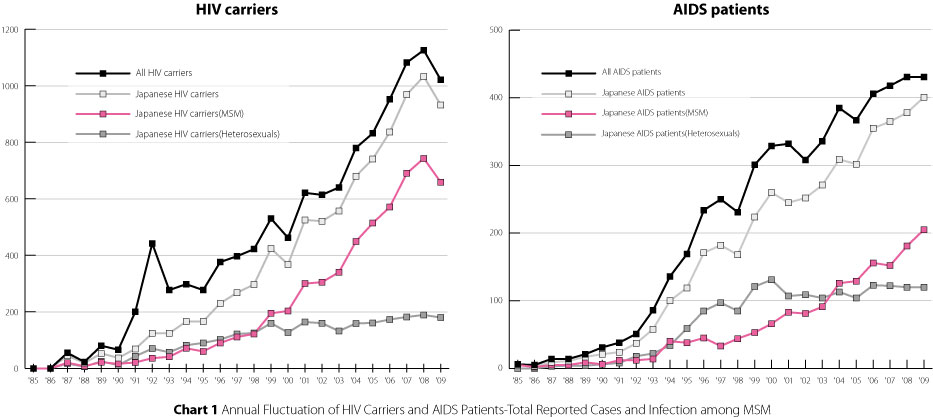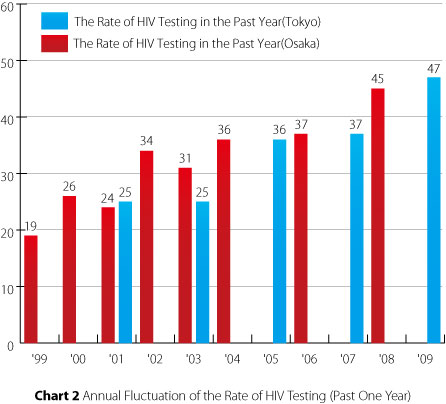Seiichi ICHIKAWA
Professor, Nagoya City University
【The article below is the same as the article that appears in the thirteenth issue of the CGS Newsletter. Charts are added.】
● The Epidemiology of HIV among MSM in Japan
From 1984, surveillance data reporting HIV infections and AIDS cases in Japan by the Ministry of Health and Welfare, now the Ministry of Health, Labor and Welfare (MOHLW) have been published in "Annual Reports of HIV Trends in Japan." The first surveillance data reports of AIDS patients in 1985 were of six notified cases, who were all infected through homosexual transmission.
While Japan is considered to be a country of low HIV prevalence, National AIDS Surveillance data indicates that since 1999, Japan is experiencing steadily increasing HIV infections. Surveillance notification data indicates that the rates of HIV infections and AIDS cases reported through heterosexual contact among Japanese nationals has remained steady since 2000. However, the rates of HIV infection and AIDS among men who have sex with men (MSM) continue steadily to increase. From 2002 to 2008, the reported numbers of HIV infections and AIDS patients among MSM doubled indicating rapidly increasing rates of HIV/AIDS reports among MSM in recent years. According to surveys conducted by the Ministry's Study Group on the Development and implementation of Community-based HIV Prevention Interventions for MSM, the rate of HIV infections among MSMs is about 3 to 5% in Tokyo and Osaka. Although the HIV actual prevalence rate among the general population is unknown, there were 2.107 positive cases out of every 100,000 HIV tests for blood donation (translating to 0.0021%). Moreover, infection rates among MSM have rapidly increased not only in the largest cities of Tokyo (since 1996), Kinki area including Osaka (since 1998), and Tokai including Aichi (since 2001). Behavioral data indicates that HIV among MSM is increasing in other regions including Tohoku, Kyushu and Okinawa as well. Under estimations of male to male sexual behavior and HIV prevalence among homosexually active men has partially contributed to increasing HIV epidemics among MSM in Asia. Estimations of homosexual populationnumbers and HIV prevalence are necessary in order to inform government HIV related policy, project planning and budget allocation for HIV prevention and support for MSM. A survey was conducted among male adults living in the Tohoku, Kanto, Tokai, Kinki, and Kyushu regions in order to estimate the number of MSM in the general population. Among 3,700 men aged between 20 and 59 years old surveyed, 1,659 men responded (indicating a response rate of 45%). Among responses, 3.7% men answered that they had experienced homosexual attraction and 2.0% had had sexual experience with only men or with men and women. Furthermore, 4.3% of men reported experiencing either sexual attraction toward or sexual experience with men. Using the results of this survey and applying it to male adult population figures obtained from the national census, the number of MSM in Japan is estimated to be over 682,000. This estimation is believed to be low due to a number of methodological issues. Using the MSM population figures and AIDS surveillance data, we calculated the HIV and AIDS prevalence rates among MSM and non-MSM using data from the 2008 Annual Report of HIV Trends. The prevalence of HIV and AIDS among MSM was found to be respectively 96 times and 33 times greater than that among non-MSM. These studies indicate that there is an urgent need to provide HIV prevention and support for MSM in Japan.

● The Community Based Response by Gay NGOs
Since 2002, the Study Group on the Development and Implementation of Community-based HIV Prevention Interventions for MSM has worked with gay NGOs to conduct research and HIV prevention projects using community development approaches. This approach encourages gay communities to carry out education and support programs for gay men by gay men. Using networks established with gay commercial venues such as gay bars, gay NGO staff and volunteers distribute condoms and educational pamphlets, and also hold education and HIV promotion events. Since 2003, with funding from the Ministry of Health, Labor and Welfare (MOHLW) administered through the Japan Foundation for AIDS Prevention in 2003, two community centers in Tokyo and Osaka for gay and bisexual men. Other centers have been established in Nagoya in 2006, Fukuoka
in 2007, and Sendai and Okinawa in 2010. Run by gay NGOs in each area, the community centers have become important bases for promoting education and awareness campaigns.
Behavioral surveys, sociological research, and program evaluation research is conducted to evaluate the gay NGO activities. A survey of MSM club event participants in Osaka indicates that HIV testing and condom purchasing are increasing year by year, with similar results found in Tokyo. However, findings from gay bar surveys conducted in Osaka and Tokyo in 2007 and 2008 indicate that MSM aged in the forties and older have lower rates of HIV testing and condom use. This indicates that older MSM need to be the target of future HIV prevention, education and support programs by gay NGOs.
In 2006, the MOHLW began funding a 5 year "Strategic Research for AIDS Prevention" research project which aims to "double the rate of HIV testing and reduce AIDS infection by 25%" among MSMs in the Tokyo metropolitan and Hanshin areas. The research team consists of gay NGO staff and researchers, and the research goals include: 1) increasing the awareness of HIV testing services and merits of early detection of HIV; 2) increasing the capacity of HIV testing facilities to meet the demand for HIV testing among MSM. In particular, testing and counseling facilities which are sensitive to the sexuality related issues of MSM who experience social prejudice and discrimination; 3) expanding counseling andsupport facilities to provide information for those who think they might need a HIV test and for those who test positive.
In order to achieve the research goals, in the Tokyo area, a website called "HIV map" has been established to increase access to HIV-related information and organizations. Moreover, Gay NGOs have held workshops with health center staff to improve the skills of HIV testing staff dealing with MSM coming for HIV testing. HIV testing services have also cooperated by publicizing information about themselves on "Anshin HIV Test Search." From 2009 to 2010, the gay NGOs started the "Dekiru!" (We can do it!) campaign to promote HIV testing, HIV prevention, and increasing the awareness of the situation faced by people with HIV and AIDS in the community. Campaigns have been promoted through networks with gay commercial facilities, organizers of club events, various media (internet, radio, magazines, TV), and gay sports and social groups. In the Hanshin area, Gay NGOs have conducted campaigns to promote HIV testing at STI clinics (clinics which treat Sexually Transmissible Infections) for MSMs. HIV testing clinics are advertised through gay community newspapers, the internet, in commercial venues, and through large events such as festivals held in parks, slide shows set to music shown in railway stations and the like. For example, "PLuS+," a park event which promotes HIV testing for those who do not necessarily go to gay bars, has been successful in attracting 5,000 to 6,000 visitors (60% of whom were MSM). In addition, a number of support services have been established including: the first counseling hotline to support those who test HIV positive ("POSP telephone counseling"), as well as peer support group meetings for newly diagnosed HIV positive MSM, and case conferences to develop networks among professional counselors in the community.
 ● Conclusion
● Conclusion
While survey results for the last three years indicate that gay NGO activities have been successful in increasing HIV testing among MSM aged 25 to 49 year-old age, they face a number of challenges. There is a need to expand activities by gay NGOs to promote awareness across a wider range of regions and to target younger and older age groups of MSM. There are many challenges currently faced by gay NGOS, such as the lack of full-time paid staff and their dependence on volunteers, low levels of public funding for Gay NGO activities, and the dependence on research funding to conduct education and promotion projects. Ongoing funding is needed for gay NGOs and community centers to continue projects of conduct HIV prevention, HIV testing information prevention, and support to MSM with HIV. High HIV and AIDS prevalence among MSM in comparison with non-MSM and yearly increasing rates of HIV infections among MSM indicates the high priority for HIV prevention and support targeting MSM. In view of this, a more concerted response is needed. The current HIV policy and level of funding for MSM in Japan has not yet been successful in halting the rapidly increasing HIV infections among MSM in Japan.